Since its inception in 1999, the Best of Sensors Expo Awards has sought to recognize those new products that meet our criteria for timeliness, distinctiveness, potential impact, application, and relation to the scope of Sensors. In other words, Is the product commercially available and has it been introduced since the last Sensors Expo? Is it unique, or at least markedly different from what's out there? Does it have the potential to change the way people work? Does it fulfill a real need? And is it a sensor or related to sensing in some way? We think that this year's winners are excellent examples of devices that meet these criteria; let me introduce you to them.
Gold Award Winners
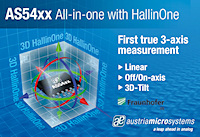
The AS5410 3D Hall sensor from austriamicrosystems
|
In the Sensors category,
austriamicrosystems earned a gold award for its AS5410 3D Hall encoder. This device was developed in cooperation with Fraunhofer Institute for Integrated Circuits IIS and integrates two 3D Hall sensor cells, an ADC, and an EEPROM. Able to measure the magnetic field components in 3D, the sensor is capable of absolute linear position sensing (with a 40 mm absolute linear position measurement range), off-axis rotation angle sensing, or multi-axis tilt sensing and can make absolute or differential measurements. As one of our judges, Ed Ramsden of Lattice Semiconductor, remarked, "it offers a great deal of flexibility and has the potential to be really useful."
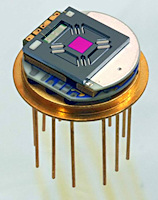
The Tunable Microspectrometer Detector Model LFP-80105-337 from InfraTec Infrared
|
InfraTec Infrared LLC, using technology developed by Fraunhofer IPMS, took home a gold award in the Sensor Components category for its Tunable Microspectrometer Detector Model LFP-80105-337 that allows you to analyze several gases simultaneously with a single-channel detector. The device combines a MOEMS-based tunable Fabry-Perot filter with a LiTaO
3 pyroelectric detector. When used with an IR source you can tune the filter wavelength step by step or continuously to measure a transmittance or reflectance spectrum in a defined wavelength range in a very short time. Melanie Martella, Executive Editor of
Sensors, noted "I love the fact that this is compact, tunable, and fills a real-world need for better gas analysis tools that don't have to be stuck in a lab."
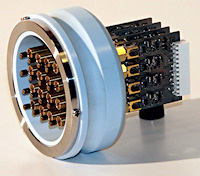
The EPIC electric potential integrated circuit from Plessey Semiconductor
|
Plessey Semiconductors Ltd. earned a gold award in the Sensor Components category for its EPIC electric potential integrated circuit that acts as a highly stable, extremely sensitive, contactless digital voltmeter to measure tiny changes in the electric field, such as those that occur in nerves or muscles. The device features an input capacitance as low as 10
–17 F, noncontact capacitive coupling, a bandwidth from quasi-DC to >200 MHz, and the ability to measure spatial electric potential or electric fields. This is a technology that's impressive on paper and jaw dropping in person. The judges loved the range of potential medical applications because the device doesn't need to be in electrical contact with the skin to measure physiologically interesting electrical signals.
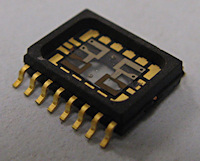
A prototype of Synkera Technologies' MikroKera chemical sensor
|
Synkera Technologies Inc. was awarded a gold in the Sensors category for its MikroKera family of chemical sensors. The sensors are based on the company's micromachined, nanostructured anodic aluminum oxide (AAO) ceramic sensing technology and experience a change in resistance when the target gas adsorbs to the sensor's MOS (metal-oxide semiconductor) layer. Not only can these sensors detect ppb levels of specific hazardous gases in real time but also they don't require preconcentration, they can withstand continuous exposure to low levels of hazardous gases, and they can remain undamaged by high levels of exposure. Because of their small size, inherently low power consumption (<1 mW on average for the CO sensor designed for use in portable devices), robustness, long life, and sensitivity, they allow designers to use chemical sensors in novel ways, including embedding them into devices such as cell phones.
Silver Award Winners
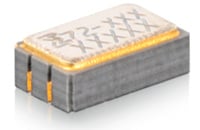
Meggitt Sensing Systems' Endevco Model 72 Series high-G shock accelerometer
|
Meggitt Sensing Systems took home a silver award in the Sensor category for its Model 72 Series high-G shock accelerometers that have a 20,000 g measurement range yet weigh a mere 0.16 grams. Designed to make high-reliability acceleration, vibration, and shock measurements (and especially for long-duration shocks) for a range of general test and measurement, automotive, and aerospace applications, the accelerometers have a broad frequency response, extending down to DC; a minimum zero-shift after the shock event; and use a highly sensitive MEMS sensing element with light gas damping to attenuate resonance, and mechanical stops to increase ruggedness and to reduce the likelihood of breakage under overload conditions. Commented Ramsden, "Anyone can make an accelerometer, but it takes skill to make one that could be cannon-launched."
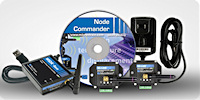
MicroStrain's mXRS extended-range wireless sensing system
|
MicroStrain Inc. took home two silver awards, both in the Data Acquisition category. The first silver award was for the mXRS extended-range synchronized wireless sensing system that builds on the company's wireless DA expertise, offering a transmission range of up to 2 km and the ability to synchronize all data to within ±32 µs by using the company's beaconing protocols to synchronize precision timekeepers embedded within each sensor node in the WSN. The base station coordinates data collection from all sensor nodes and can synchronize and collect data from 2016 nodes at 2 Hz; 224 nodes at 16 Hz; 32 nodes at 128 Hz; or 4 nodes at 512 Hz. The combination of scalability, seriously synchronized data, and long transmission range impressed the judges.

MicroStrain's SensorCloud sensor data storage, visualization, and remote management platform
|
MicroStrain's second silver award was for the SensorCloud platform that supports any Web-connected third-party device, sensor, or sensor network. The judges loved that this product leverages cloud technology to make large-scale sensor networks more useful by providing powerful sensor data storage, visualization, analysis, and remote management tools designed for and tailored to working with huge data sets. Said Martella, "if wireless sensor networking really is going to become as pervasive as we predict, tools such as this—to store, manage, analyze, and use the vast quantities of data that will result—are key to their successful and efficient adoption."
Bronze Award Winners
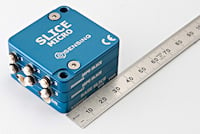
The SLICE MICRO IEPE tiny stand-alone data recorder from DTS
|
DTS Inc. earned a bronze award in the Data Acquisition category for its SLICE MICRO IEPE ultra-small data recorder designed to collect data from IEPE sensor types. Each module is 42 by 42 by 10 mm, has TEDS support, and offers sampling rates to 120 Ksps/channel, bandwidth from DC to 45 kHz (AC and DC), and 25 V excitation with 2–4 mA constant current regulation (2.5 mA typical). Not only that, but it records up to 4 hours of data to its 7 GB of nonvolatile flash memory. The modules can be stacked for up to 24 channels per stack or daisy-chained for hundreds of channels, an invaluable feature for in-flight testing, which is what this system was designed for. DTS has made a name for itself by creating tiny, rugged, and capable systems that enable high-performance DA in areas that weren't possible before. "I don't understand how they manage to fit quite so many features into such a tiny and rugged envelope (it's shock rated up to 500 g), but they do," noted Martella. She continued, "I can't wait to see what they do next."
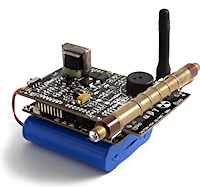
The Radiation Sensor Board from Libelium
|
Libelium took home a bronze award in the Data Acquisition category for its Radiation Sensor board that couples a Geiger counter with its Waspmote wireless sensor networking platform to create an emergency radiation sensor network. Each node acts as an autonomous and wireless Geiger counter, measuring the level of beta and gamma radiation, and sending the readings—along with GPS information—to a control center via ZigBee and GPRS. High-load batteries provide years of life and the system can send SMS alarms when radiation values exceed a specified threshold. The judges loved how timely this product is; it illustrates all the qualities that make wireless sensor networks such a vital, exciting and, above all, useful technology—it is rapidly and flexibly deployed and it gives you information you need, in a useful form, and fast.
Honorable Mentions
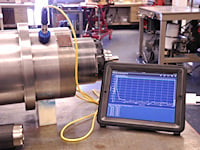
The iPad vibration analyzer from GTI Spindle Technology
|
The judges awarded
GTI Spindle Technology an honorable mention in the Technologies category for its iPad vibration analyzer that collects data through an attached accelerometer and channels it through the company's hardware into the iPad. You can view the vibration spectra on the iPad as well as send the spectra to an outside expert for analysis. It's an elegant and functional tool that puts vibration analysis into the hands of a wider audience.
Hoffmann + Krippner earned an honorable mention in the Sensors category for its Moog QuieSense noiseless thin-film membrane potentiometer. The sensor is formed by printing highly sensitive resistive ink on Kapton and then linearizing the readings, resulting in a linearity of 0.1%. In what is a very crowded field, Hoffmann + Krippner have achieved 0.1% linearity, a fact that impressed the judges tremendously.
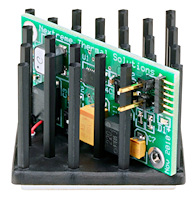
The Thermobility WPG-1 thermal energy harvester from Nextreme Thermal Solutions
|
Our last honorable mention went to
Nextreme Thermal Solutions, in the Sensors category, for its Thermobility WPG-1 wireless power generator. The company's novel solid-state thin-film thermoelectric technology forms the heart of this device, which provides a constant voltage output of 3.3, 4.1, or 5.0 VDC. The golf-ball-sized WPG-1 consists of a heat sink, a circuit board, the company's eTEG HV56 thermoelectric power generator module, and a metal attachment plate. It provides up to 1mW of electrical power and operates at temperature differentials as low as 15–20 K relative to ambient. The judges liked that this product expands the range of energy harvesting technologies available today.
ABOUT THE AUTHOR
Melanie Martella is the Executive Editor of Sensors. She can be reached at 603-924-3246, [email protected].










